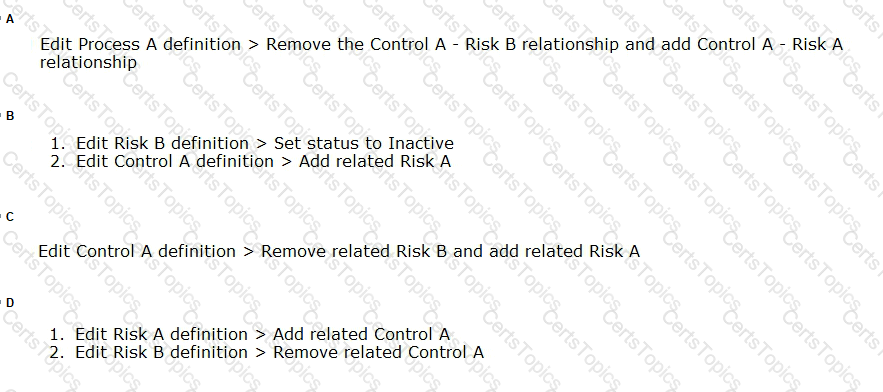Your client has three operating units.
What are two ways in which you can exclude an operating unit where there are not enough personnel to allow segregation of duties? (Choose two.)
Your customer has a requirement to define an IT Compliance Manager job role with privileges to manage risks and controls, and the issues related to the risks and controls.
What are the duty roles that must be included in this job role to achieve this requirement?
An organization has a list of companies with which they no longer wish to do business. The list is not stored in their ERP Could but is stored in a file.
Which transaction model will identify payments made to these companies?
How do you associate a risk to a control?
Which two options can be assigned to a duty role? (Choose two.)
You want to identify Controls with the most Incidents, with the condition that the identified Controls should have 80% of all Incidents. To do this, you have imported a custom object that contains the number of incidents associated with each control, and have added that object to a transaction model.
Which pattern filter must you now apply?
You build an access model with two entitlements. Each entitlement has four access points. The entitlements do not have any access points in common.
How many access point combinations will be analyzed?
An assessor is trying to complete an operational assessment on a control for manual AP Invoice entry and is reviewing Prior Results.
Which statement is true about viewing Prior Results for this control?
During an assessment, an issue was created. Your job as the Issue Manager is to review the issues and validate them. If it is determined that they are not valid issues, you need to close them. You have found an issue that is not valid and with Status: Open and State: Reported.
Identify the correct step to close this issue.
Which statement related to Advanced Access Controls is true?
When validating imported data, the control manager at your client has identified an incorrect Risk-Control mapping; that is, Control A was mapped incorrectly to Risk B instead of Risk A. What needs to be done to fix the mapping?

You have completed the data import process with no errors. You created process, risks, controls, and one perspective. Controls were related to perspectives. You have provided the customer with the Control Manager security role. When the customer logs in to Financials Risk Compliance (FRC), the customer cannot see any controls.
Which step was missed during the import process?
Which two steps are required to set up two levels of approval for new controls, which are added after the initial import? (Choose two.)
Your client is configuring their Test pod (which has no data) and has created their initial import template with controls, test plans, perspectives, and perspective-control mappings. They have used custom list of values for Control Frequency.
Which three tasks must be completed before performing the data import? (Choose three.)
The GRC Business owner responsible for reviewing and investigating access incidents related to the “Order to Cash” perspective does not see any worklists for the generated results. You have validated that:
1. Other business owners are able to view their assigned worklists without any problem
2. Incidents have been generated for the controls related to Order to Cash
3. The business owner’s assigned roles contain the correct functional privileges and data access to the correct perspective values
What is the reason the business owner cannot see any worklists for the generated incidents?
Which three objects can be related to issues when creating an issue on the Manage Issues page? (Choose three.)
You completed the data migration successfully. You created 100 controls, an Organization Perspective, and relationship of controls to the Organization Perspective. All controls are related to one perspective item. The Control Manager logs in to the application to view the new controls, yet there are none available for his or her review.
Identify three reasons for this. (Choose three.)
You have created a risk definition R100 and have created a new control C100 for this risk. No user has been assigned the Risk or Control reviewer and approver roles. What will be the state of R100 and C100 after submitting?
You are remediating access incidents in Advanced Access Controls (AAC), and have just completed the remediation of a segregation of duties conflict for users in Fusion Security by removing the conflicting access from the users.
What status do you set for the incident in AAC?
Which two activities can be performed using Financial Reporting Compliance? (Choose two.)
You have built a transaction model to identify possible duplicate charges between invoicing and expense credit cards. The model logic already includes two standard filters that identify amounts and suppliers that are the same or similar, as shown:

Which additional date filter will further refine the set of duplicate charges found?
You are configuring security and you do not want the risks to go through the review and approve process each time they are updated. How will you meet this requirement?